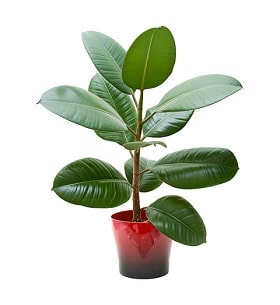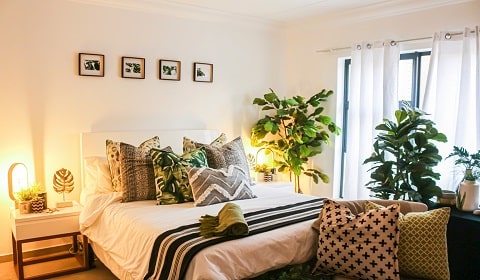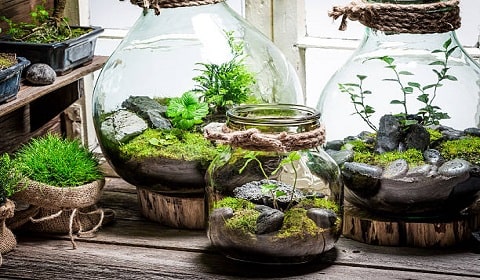Best bedroom plants elevate both aesthetics and well-being. Introduce lush foliage to your sanctuary for a serene ambiance and health perks.
Research by NASA 1989, select plants actively cleanse indoor air, diminishing pollutants like benzene and formaldehyde. Recent studies underline their stress-relieving properties, fostering relaxation and promoting restful sleep.
Embrace this natural decor trend to cultivate a tranquil haven conducive to rejuvenation. With a touch of greenery, transform your sleeping quarters into an oasis of purity and serenity. Your body and mind will gratefully embrace the revitalizing embrace of air-purifying plants.
Best Bedroom Plants
Bringing nature into the bedroom can significantly improve the ambiance, air quality, and even your sleep quality.
Plants not only add a touch of greenery but also purify the air by removing toxins and releasing oxygen. With numerous options available, choosing the right plants for your bedroom can be overwhelming.
Here’s a curated list of the 15 best bedroom plants that not only beautify your space but also promote a restful environment.
Table of Contents
1: Lavender (Lavandula)
Lavender, often associated with outdoor gardens, can actually thrive indoors with proper care. Beyond its aesthetic appeal, it offers air-purifying properties and aroma therapeutic benefits, especially beneficial in bedroom settings.
Best bedroom plants, research indicates that inhaling lavender essential oil can lower blood pressure and heart rate, promoting relaxation and better sleep quality. Incorporating this fragrant plant into your indoor space can contribute to a calming atmosphere conducive to restful sleep.
So, before retiring for the night, take a moment to indulge in the soothing scent of lavender for a peaceful slumber.
Bedroom Plant Care Tips: Lavender thrives with bright, direct sunlight for several hours daily, ideally in a south-facing window. Water it when the soil becomes slightly dry, but avoid overwatering to prevent root rot. A balanced approach to light and water will help maintain the health and vitality of your lavender plant.
Read More: Rose Gardening Ideas
2: Rubber Plant (Ficus elastica)
This plant boasts large, glossy leaves that shine in the light, creating a vibrant presence in any space. Its unique, beefy shape adds a touch of playfulness and personality, making it a standout feature in a room, especially among the best bedroom plants.
With its strong vertical growth, it draws the eye upward, adding dimension and depth to the environment. Whether placed in a corner or as a focal point, this plant brings an element of nature indoors, creating a refreshing and inviting atmosphere.
Its lush foliage adds texture and greenery, contributing to a sense of vitality and well-being in its surroundings.

Bedroom Plant Care Tips: This plant thrives in moderate to bright light and requires consistent moisture. When pruning, it’s essential to wear gardening gloves to avoid getting its sticky sap on your fingers.
3: Wekiva Foliage Lady Palm (Rhapis excelsa)
This elegant plant features multiple fronds arranged in a stunning fan pattern, adding beauty to any interior decor style. Best bedroom plants, its effortless growth makes it a suitable choice for both novice and experienced plant enthusiasts alike.
Compared to other palm varieties, this plant is relatively easy to cultivate, requiring minimal maintenance while still thriving in various environments. With its graceful appearance and low-maintenance nature, it serves as an attractive addition to any space, enhancing the ambiance and bringing a touch of natural charm indoors.
Bedroom Plant Care Tips: Lady palms thrive in bright, indirect light and should be watered only when the top inch of soil feels dry to the touch. They prefer consistently moist soil but are prone to root rot if overwatered. These elegant plants can adapt well to indoor environments and make for stunning additions to any space with their graceful foliage and low maintenance requirements.
4: English Ivy (Hedera helix)
This resilient ivy plant flourishes in various settings, including pots, hanging baskets, or when combined with taller houseplants in a communal container. Its versatility allows it to adapt to different environments, making it a popular choice for indoor decoration, especially among those looking for the best bedroom plants.
With its ability to thrive in confined spaces and complement other plants, it adds aesthetic appeal and greenery to any indoor setting.
Bedroom Plant Care Tips: English ivy thrives with moderate light in spring and summer, but it craves brighter conditions (or supplemental fluorescent light) in fall and winter. Keep the soil slightly dry between waterings, but ensure it doesn’t completely dry out. This plant’s health depends on striking the right balance of light and moisture throughout the year to maintain its lush foliage.
5: California Tropicals Areca Palm (Chrysalidocarpus lutescens)
The plumes of this stunning palm tree can grow up to 6 to 7 feet tall, requiring ample space to flourish. Its majestic appearance adds a touch of elegance to any landscape or indoor setting, making it one of the best bedroom plants. Ensure proper room for growth to allow the palm to reach its full potential and showcase its beauty.
Bedroom Plant Care Tips: The areca palm thrives in bright indoor light. During spring and summer, it requires consistent but not excessive moisture. Avoid letting the soil become soggy, as this can lead to root rot. Proper care ensures the health and vitality of your areca palm, allowing it to flourish in its indoor environment.
6: Boston Fern (Nephrolepsis exaltata)
Lush ferns are a timeless, affordable choice for indoor greenery with their beautiful, arching fronds. Their vibrant green color adds a touch of elegance to any space.
Best bedroom plants, However, caring for them indoors can be a bit demanding, as they require specific conditions to thrive. Despite this, their beauty makes them a popular choice for those looking to bring a touch of nature into their homes.
Bedroom Plant Care Tips: Boston ferns thrive in bright light and require daily misting or placement on a water-filled pebble tray for humidity. Additionally, they shed regularly, necessitating regular cleanup. Like caring for a child, tending to these ferns demands consistent attention and maintenance to ensure their health and vitality.
7: Costa Farms Chinese Evergreen (Aglaonema commutatum)
This plant is characterized by its glossy, pale green leaves adorned with white markings, making it visually striking and appealing. Best bedroom plants with its easy-to-grow nature, it’s a popular choice for both beginner and experienced gardeners alike.
The contrast between the green and white adds a touch of elegance to any indoor or outdoor space. Its low maintenance requirements make it a hassle-free addition to any garden or home, providing beauty without demanding extensive care.
Bedroom Plant Care Tips: Chinese evergreen is a low-maintenance indoor plant that thrives in low light and requires consistently moist soil. However, it is sensitive to cold air and should be kept away from drafts to prevent damage. With proper care, this plant can add a touch of greenery to any indoor space while requiring minimal attention from its owner.
8: Snake Plant (Sanseveria trifasciata)
This plant, known as the “mother-in-law’s tongue,” features dramatic, sword-like leaves that make it stand out. It’s incredibly resilient and can thrive even if you’re not great at caring for plants. With the right conditions, it can live for decades, making it a long-lasting addition to any space.
Best bedroom plants often include species like the snake plant for their air-purifying properties and low maintenance requirements, making them ideal choices for enhancing your sleep environment.
Bedroom Plant Care Tips: This plant thrives in bright, indirect light and should only be watered when the soil is almost dry. It’s low-maintenance and doesn’t require frequent watering, making it ideal for those with busy schedules or less experienced plant owners. With the right conditions, it will flourish and add a touch of greenery to any space without demanding too much attention.
9: Dracaena (various species)
Several types of dracaena are known for their air-purifying qualities, boasting long, strappy leaves often adorned with striking red markings. Best bedroom plants include popular varieties such as the dragon tree, particularly the visually captivating ‘Tricolor’ variant, ‘Janet Craig’, and ‘Masangeana’, also known as the “corn plant”.
These plants are low-maintenance and easy to grow, making them a great choice for indoor spaces seeking a natural air purification solution.
Bedroom Plant Care Tips: Dracaena species thrive in moderate to bright indirect light and soil that’s kept lightly moist. Regardless of the specific type of Dracaena you choose, these general conditions will support its growth.
Whether it’s the Dracaena marginata, Dracaena fragrans, or any other variety, ensuring adequate light and maintaining slightly damp soil will promote healthy development. Consider these factors when caring for your Dracaena plant to help it thrive in its environment.
10: Wekiva Foliage Split-Leaf Philodendron (Philodendron Selloum)
The spectacular plant boasts large leaves with delicate, lacelike edges, making it both impressive and low-maintenance.
Its size is noteworthy, as it can reach heights of 3 to 4 feet and widths of 2 to 3 feet, so ample space is necessary for its growth. For those seeking the best bedroom plants, this plant’s easy-care nature makes it an attractive addition to any garden or indoor space.
Despite its grandeur, this plant is easy to care for, making it an attractive addition to any garden or indoor space.
Bedroom Plant Care Tips: To care for your plant properly, provide it with moderate light and water it only when the top layer of soil dries out. Overwatering can lead to root rot, so it’s important to let the soil dry between waterings. By ensuring it receives the right amount of light and water, you can help your plant thrive and maintain its health.
11: Dieffenbachia (various hybrids)
This plant boasts vibrant leaves, but beware: its sap harbors irritating crystals that can aggravate mucous membranes. Not pet-friendly due to the risk of ingestion.
However, for those without furry companions, it thrives as a low-maintenance indoor plant, adding aesthetic charm to any bedroom. For even more appeal, consider it among the best bedroom plants.
Bedroom Plant Care Tips: Dieffenbachia thrives in moderate filtered light, making it ideal for indoor environments.
It requires soil that is kept lightly moist, but it’s crucial not to overwater and make the soil soggy, as this can lead to root rot. By maintaining these conditions, the Dieffenbachia plant can grow healthily and flourish in its environment.
12: Rosemary (Rosmarinus officianalis)
This culinary herb has a delightful piney fragrance, especially noticeable when brushing fingertips against it. It’s recommended to do so in the morning upon waking up, as research indicates its scent can refresh the mind and boost mood. For those looking to enhance their bedroom environment, consider adding the best bedroom plants for a touch of nature indoors.
Surprisingly, this bedroom plant offers an immediate dose of motivation to kickstart your week. With its therapeutic properties and invigorating aroma, it’s no wonder this herb is a favorite among those seeking a natural pick-me-up.
Bedroom Plant Care Tips: Indoors, rosemary thrives in strong light, ideally near a south-facing window. It’s essential to let the soil dry about an inch deep before watering, preventing root rot. Additionally, rotating the pot weekly promotes even growth. These practices ensure optimal conditions for rosemary, allowing it to flourish as a vibrant and aromatic herb indoors.
13: Spider Plant (Chlorophytum comosum)
The Spider Plant, a beloved classic houseplant from the ’70s, remains a popular choice for homes today, especially as one of the best bedroom plants. Its distinctive striped leaves arch gracefully from the center, adding a touch of elegance to any space.
As an added bonus, the plant produces numerous baby Spider Plants, known as “plantlets,” which are adorable and easy to propagate. Whether it’s a nostalgic choice or a new addition to your home, the Spider Plant is sure to bring charm and vitality to any room.
Bedroom Plant Care Tips: This plant thrives in environments with moderate to high levels of light and requires consistent watering to maintain adequate moisture levels. It is best suited for locations where it can receive a balance of natural sunlight and indirect light.
Additionally, it benefits from regular watering to prevent the soil from drying out completely. Overall, providing medium to bright light and steady moisture will help this plant thrive.
14: Pothos (Epipremnum aureum)
Pothos, a popular houseplant, is known for its simplicity in care. With its glossy heart-shaped leaves and sprawling vines, it can thrive in various conditions and environments. Best bedroom plants, Pothos requires minimal attention and can grow long stems, making it a versatile and visually appealing addition to any indoor space.
Bedroom Plant Care Tips: Pothos, a popular houseplant, thrives in moderate to bright light conditions and benefits from allowing the soil to dry slightly between waterings.
This low-maintenance plant is known for its resilience and ability to adapt to various indoor environments. By providing it with the right amount of light and allowing the soil to partially dry out, you can help ensure its health and longevity.
15: Peace Lily (Spathiphyllum species)
These opulent plants exude luxury but require minimal maintenance, making them the best bedroom plants. Despite their lavish appearance, they are surprisingly easy to care for, making them an ideal choice for both novice and experienced gardeners alike. With their effortless upkeep, they add a touch of elegance to any space without demanding constant attention or specialized care.
Bedroom Plant Care Tips: Peace lilies are adaptable plants that can thrive in low to moderate light conditions, but they prefer brighter light for optimal blooming. It’s best to let the soil dry out almost completely before watering them.
Additionally, dividing the plant every five years can help propagate new baby plants. With proper care, peace lilies can beautify indoor spaces with their lush foliage and elegant white flowers.
Read More: How To Grow Healthy Rose




